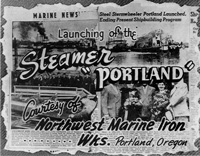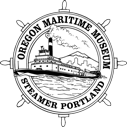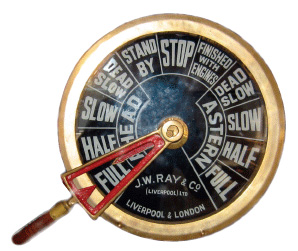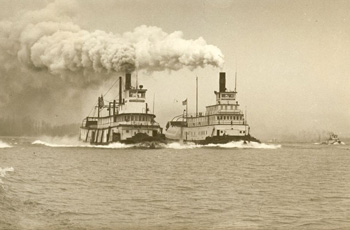History
|
Established in 1980, the Oregon Maritime Museum's mission is to:
The Portland is the last steam-powered, sternwheel tugboat to be built in the United States. The Port of Portland took delivery on August 29, 1947 and she immediately went into service. The Portland assisted ships to dock, turn and pass through the narrow bridge spans on the Willamette River. Her massive rudders and backing power were essential for moving loaded ocean-going ships. When you visit the steamer Portland today, you see the result of more than a million dollars worth of volunteer labor over 15 years to restore the steamer Portland. The deckhouse is rebuilt, and new systems are installed. The boat comes alive again when the sternwheel rotates and the sound of the whistle fills the valley! The Portland is the last operating sternwheel steam towboat in the United States. |
1952 Tugboat Race: |
The Past

Program for the launching
of the Portland
1946 | The Port of Portland realized the need to replace the wooden hulled, sternwheeled tug Portland that had served the area from 1919. A diesel-powered screw tug was initially proposed, but the Columbia River Pilots Association wanted another sternwheeled tug. They depended on the power and unusual ship handling ability only sternwheeled tugs could deliver at the time. The pilots prevailed.
1947 | On February 3, the keel was laid at Northwest Marine Iron Works and the new Portland took shape.
1981 | After almost 30 years of service in and around the Portland harbor, the stately Portland yielded the harbor to diesel-powered youngsters. The Port of Portland faced economic realities, and decided to retire the labor-intensive steam tugboat in 1981.
The Port Commission was reluctant to send her to the ship breakers and tried in vain to sell her to commercial interests. She sat some years at Terminal One, quietly rusting. Her wheelhouse and “Texas” house were removed and rested on the dock. Her wooden superstructure rotted away down to the steel housing of her machinery space. The powerful sternwheel dried and cracked where exposed and the underwater surface grew long tendrils of marine plants.
1991 | The sad remains of the once-proud Portland were deeded to the Oregon Maritime Museum. With funds from Meyer Memorial Trust, Murdock Charitable Trust and the Port of Portland, a group of dedicated volunteers began restoration of the last steam powered sternwheel tug. The work is never-ending, and the results are well worth the effort. Today, the steamer Portland gleams inside and out.
The museum library has several personal scrapbooks and photos of the steamer in this decrepit condition. Her grand return was broadcast on local television stations. Currently, this information is not in the digitized archives.
1997 | On August 14, Portland was entered into the National Register of Historic Places.
The Museum
In 1980, Capt. Bill Peterson and Dr. Everett Jones from the Nautical Society of Oregon joined together with Lloyd Knudsen, Capt. Bill Speidel, and E.R. “Del” Ricks to organize a maritime center and museum in Portland, Oregon. Through their efforts, the Oregon Maritime Center & Museum opened on October 29, 1986 at the historic Smith Block Building on Portland’s waterfront.
Oregon Maritime Center & Museum developed its museum facility, built membership, obtained donor support and acquired maritime artifacts. Educational programs were developed and the very successful watchstander program of volunteer docents was instituted. An extensive and diverse support group of generous people, businesses and foundations began to materialize. Local unions were particularly generous with contributions of labor and materials, as were a number of Portland-area businesses.
During the 1990s, Oregon Maritime Center & Museum achieved landmarks as an organization and proved itself to be a vital regional cultural resource. In 1991, the Port of Portland donated the steam-powered, sternwheeler tugboat Portland to Oregon Maritime Center & Museum. With many more volunteer hours and approximately $700,000 in grants and donations, the Portland was nearly completely restored by 1993. In 1994, the Portland was moved to its current moorage on the Willamette River and is open to the public. In recognition of its unique status, and to continue its preservation, the steamer Portland was placed on the National Register of Historic Places in 1997.
In 2002, rent increases at the Smith Block Building required the museum to vacate its land-based facility and selected exhibits were moved to the Portland. Since then, the museum has added to its video-based and interactive exhibits, expanded the museum store operation and increased its visibility on the Portland waterfront.
In 2004, Oregon Maritime Center & Museum was rebranded as the Oregon Maritime Museum.
Vessels in Our Collection
Portland | The sternwheel steam tug Portland is part of the Oregon Maritime Museum collection. It is our most visible presence to the public and it currently houses part of our collection and the Museum Store.
Russell (barge) | Tied alongside the steamer Portland and provides extra storage and work space for the volunteer crew.
Mom’s Boat (gillnetter) | Stored on the deck of the barge Russell and not open to the general public for safety reasons. Mom’s Boat was built during the winter of 1929-30 at the George & Barker cannery site in Astoria, Oregon. The boat was built by Ed Wahl for Oscar Haglund. The original materials used in the gillnetter’s construction were white oak ribs, now called frames, and Port Orford cedar planking. These sturdy materials—which are impossible to find today—allowed the boat to survive the rigors of fishing in the Northwest. These boats were the first square or transom stern boats built for Columbia River fishing and were very fast for their period.
More details about these vessels and Columbia River fishing can be found in our library.


